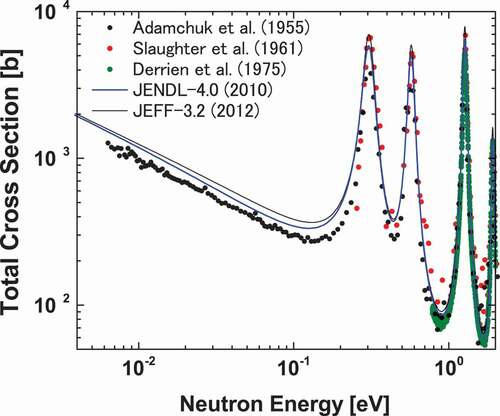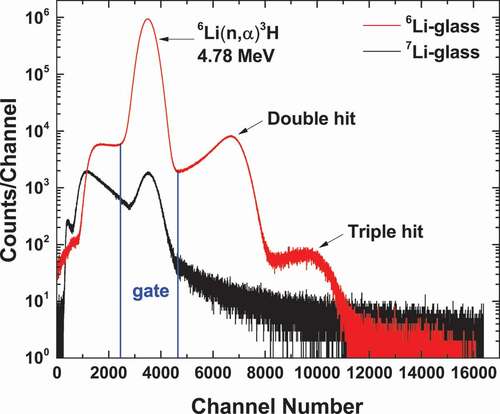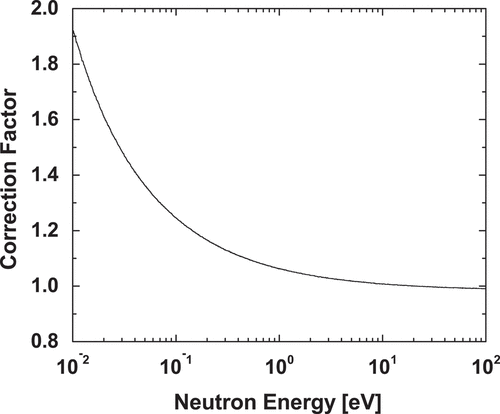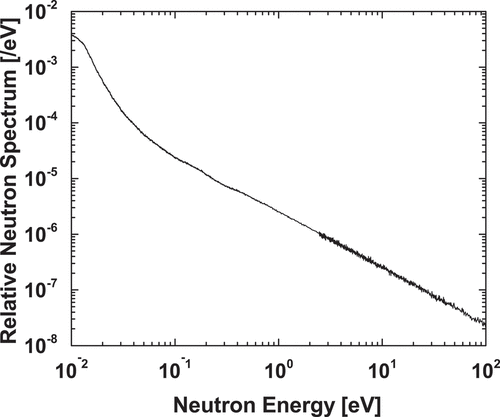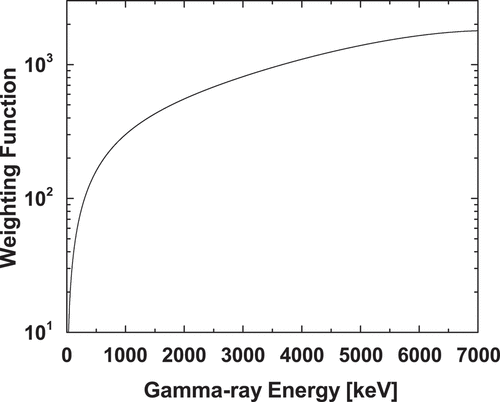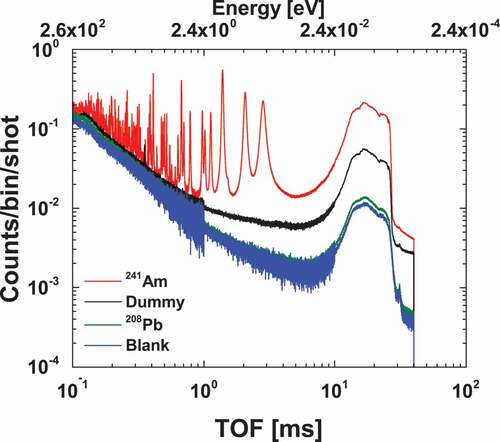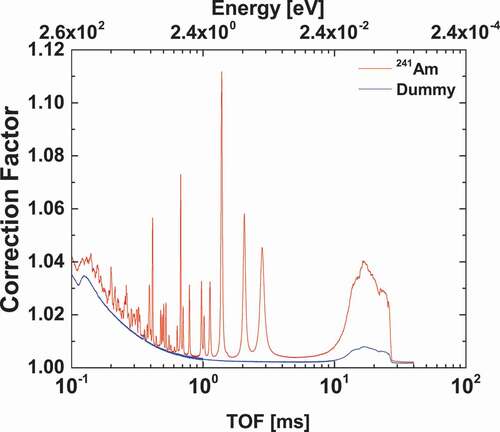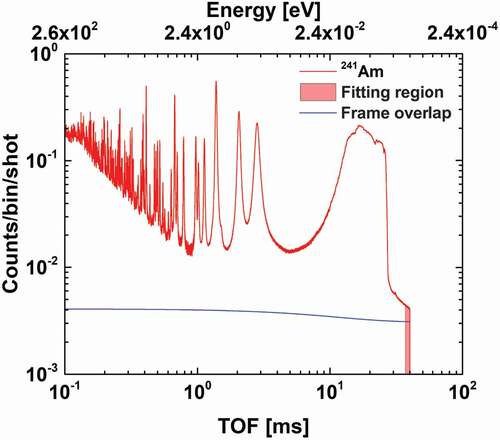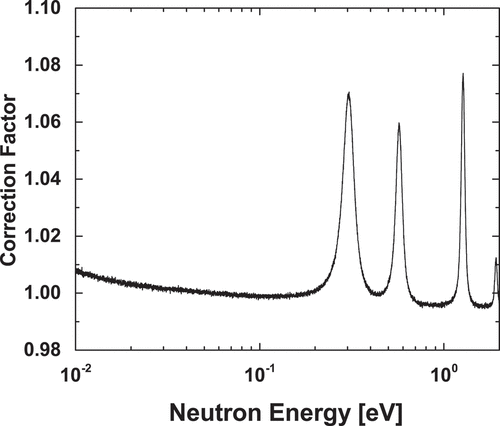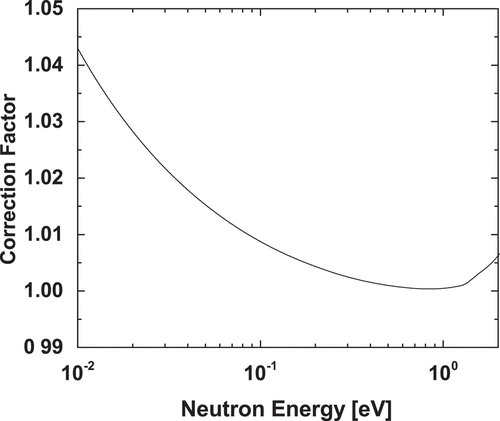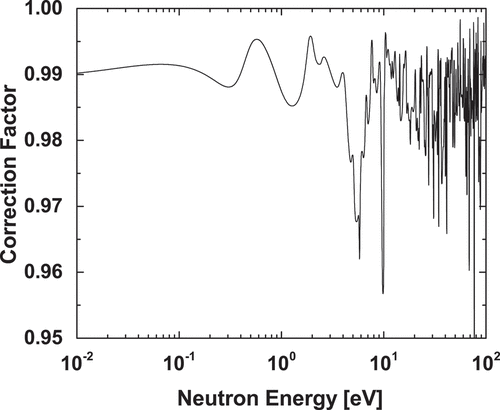 ?Mathematical formulae have been encoded as MathML and are displayed in this HTML version using MathJax in order to improve their display. Uncheck the box to turn MathJax off. This feature requires Javascript. Click on a formula to zoom.
?Mathematical formulae have been encoded as MathML and are displayed in this HTML version using MathJax in order to improve their display. Uncheck the box to turn MathJax off. This feature requires Javascript. Click on a formula to zoom.ABSTRACT
Neutron total and capture cross sections of 241Am have been measured with a new data acquisition system and a new neutron transmission measurement system installed in Accurate Neutron Nucleus Reaction measurement Instrument at Materials and Life Science Experimental Facility of Japan Proton Accelerator Research Complex. The neutron total cross sections of 241Am were determined by using a neutron time-of-flight (TOF) method in the neutron energy region from 4 meV to 2 eV. The thermal total cross section of 241Am was derived with an uncertainty of 2.9%. A pulse-height weighting technique was applied to determine neutron capture yields of 241Am. The neutron capture cross sections were determined by the TOF method in the neutron energy region from the thermal to 100 eV, and the thermal capture cross section was obtained with an uncertainty of 4.1%. The evaluation data of JENDL-4.0 and JEFF-3.2 were compared with the present results.
1. Introduction
Accurate nuclear data are indispensable for the study of nuclear transmutation system. Sensitivity and uncertainty analyses of reactor physics parameters were performed recently for the accelerator-driven system (ADS) proposed by the Japan Atomic Energy Agency using the covariance of JENDL-4.0 [Citation1,Citation2]. Impact of improving accuracy of relevant nuclear data was quantitatively shown, for example, the uncertainty of was estimated to be about 1% that is about three times larger than the required accuracy for designing the reactor system. According to the investigation, capture cross sections of minor actinides (MAs) are one of the most important data [Citation3].
Especially, the uncertainty of capture cross section on 241Am has large contributions in the uncertainties of neutronics characteristics in the ADS core. In order to satisfy the required uncertainty on k estimation, accuracy for all of the highly contributing nuclear data such as capture cross section of 241Am are needed to be improved about a factor 3. Currently, there are large inconsistencies exceeding reported experimental uncertainties between the data in publication, because of experimental difficulty in capture cross-section measurement for radioactive materials. Due to this discrepancy, a large uncertainty need be adapted in the evaluated nuclear data file. For example, the uncertainty of the capture cross section for 241Am is about 7% [Citation4]. To overcome this situation, reliable and accurate experimental method is required to be developed.
To meet the requirement, a research project entitled ‘Research and development for Accuracy Improvement of neutron nuclear data on Minor ACtinides (AIMAC)’ was started [Citation5,Citation6]. The challenging goal of the project was to reduce the uncertainties of the capture cross sections of 237Np and 241,243Am to half of the present values by integrating specialists’ leading-edge knowledge and techniques. For confirming the accuracy of the measurements, to reduce systematic uncertainties, a consistency check of two independent measurements was considered to be effective. In the case of the neutron cross sections of 241Am, its capture neutron cross-section accounts for 98–99% of its total neutron cross section at low-energy region. Therefore, the comparison between total and capture cross sections can be used for this consistency check in the case of 241Am. To enable this comparison, a new data acquisition (DAQ) system and a new neutron transmission measurement system have been developed in Accurate Neutron Nucleus Reaction measurement Instrument (ANNRI) at Materials and Life Science Experimental Facility (MLF) in Japan Proton Accelerator Research Complex (J-PARC) [Citation7]. The new DAQ system achieved 90% live time for 100 kcps event rate. Moreover, we have developed the techniques accurately determining the sample mass by two different methods: calorimetric method and gamma-ray spectroscopic method [Citation8]. The reason is that uncertainty due to the sample mass is one of the most important factors contributing to the discrepancies of measured cross-section data [Citation9–Citation12]. These approaches enable us to reduce the uncertainty on both neutron total and capture cross-section measurements.
In the past, several measurements of neutron total cross sections of 241Am have been performed [Citation13–Citation19]. shows the present status on total cross sections of 241Am. A large discrepancy exists among the previous measurements at the first and second resonances. It was also pointed that there is an inconsistency between measured neutron total and capture cross sections of 241Am [Citation20]. Precise measurements of neutron total cross sections for 241Am are indispensable. In addition, various measurements of neutron capture cross sections on 241Am have been carried out by activation and time-of-flight (TOF) methods [Citation10,Citation17,Citation21–Citation36]. Currently, there are discrepancies among the previous measurements of the thermal neutron capture cross section of 241Am [Citation37]. These discrepancies cause the large uncertainty of the current evaluated nuclear data.
From the viewpoint described above, we measured the neutron total and capture cross sections of 241Am by utilizing the state-of-the-art techniques. The measurements of neutron total cross sections of 241Am are described in Section 2. The measurements of neutron capture cross sections of 241Am are mentioned in Section 3. Finally, the conclusion is given in Section 4.
2. Neutron total cross-section measurements
2.1. Experimental procedure
Neutron total cross sections of 241Am were measured with ANNRI at the MLF of the J-PARC. An 241Am sample having an activity of 957 MBq and a dummy sample were prepared for measurements of neutron total and capture cross sections. Neutron transmission TOF spectra for the samples have been measured with two types of Li-glass scintillation detectors. The details of experimental procedure and data analysis were described in Ref. [Citation7], so it is briefly described in below.
2.1.1. J-PARC accelerator
Neutrons were produced via the spallation reactions induced by a 3-GeV proton beam impinging on a mercury target of the MLF [Citation38]. The 3 GeV rapid cycling synchrotron was operated in single-bunch mode with a repetition rate of 25 Hz. The proton beam power on the spallation target was 195 kW in the total cross-section measurements. The neutrons emitted from the spallation target were moderated by liquid hydrogen moderators cooled at 19 K and were guided into the ANNRI. A signal from a proton beam pulse monitor located in a beam transport tube to the spallation target was used as the start trigger for the TOF measurements. The number of proton beam pulses was recorded and used for normalization of each measurement.
2.1.2. Samples
The characteristics of the 241Am and the dummy samples are summarized in . The Am sample was prepared by compression molding of mixtures of AmO2 powder and Y2O3 powder into the form of a pellet with a diameter of 10.0 ± 0.1 mm and a thickness of 0.50 ± 0.05 mm, then the pellet was sealed in Al containers with a thickness of 0.1 mm. Similarly, the dummy sample, which contains a Y2O3 pellet, was prepared. For the derivation of the number of 241Am atoms, the activity of the Am sample was determined with a calorimetric method. Decay heat of the Am sample was measured accurately with a precision of 200 nW by using the TAM-IV calorimeter manufactured by TA Instruments, and thus the activity of the Am sample was obtained with an uncertainty of 0.05% [Citation8]. The isotopic composition of the Am sample was analyzed by thermal ionization mass spectrometry and alpha-ray spectroscopy [Citation39]. The determined isotopic purity of 241Am was more than 99.9996%, and the isotopic contamination due to other isotopes was less than 0.0004%.
Table 1. Characteristics of the samples
2.1.3. Transmission measurements
These samples were placed at the most upper stream part of the intermediate collimator having a diameter of 9 mm installed in the ANNRI [Citation40,Citation41]. The distance between the moderator and the samples was 24 m. Two types of Li-glass scintillation detectors were utilized for transmission measurements. A GS20 6Li-glass detector (PMT:H7195) manufactured by OKEN with dimensions of 50 mm × 50 mm and a thickness of 1 mm using enriched 6Li (6Li ) was used to obtain transmission neutron TOF spectra. Neutrons passing through the samples are detected by the 6Li-glass detector via the 6Li(n,
)3H reactions. Additionally, to determine background except for neutrons, a GS30 7Li-glass detector (7Li
) with the same size of the 6Li-glass detector was used. The 7Li-glass detector was located on the upstream side of the 6Li-glass detector. Distance from the moderator to the 6Li-glass detector was 27.8 m. Signals from these detectors were fed into the DAQ with a CAEN V1720 (12 bit 250 MHz) module to calculate timing and pulse height (PH) data. The timing and PH data were recorded in an event-by-event mode. Measurements were carried out with a lead block having a thickness of 5.0 cm placed on the neutron beam line in order to reduce the dead time of the Li-glass detectors caused by intense gamma-rays from the moderator. The black resonance technique was applied using neutron notch filters of natMn, natCo, natIn, and natAg to estimate the background due to frame-overlap neutrons [Citation42]. The measuring times of the 241Am and the dummy samples were 8 and 7 h, respectively.
2.2 Data analysis
shows PH spectra of the 241Am sample measured with the 6Li-glass detector and the 7Li-glass detector. Peaks around 3500 ch. are due to the 6Li(n,)3H reactions. Double-hit and triple-hit peaks were also observed in the spectrum measured by the 6Li-glass detector. The double-hit and triple-hit peaks were enough small comparison to the single-hit peak, and the influences of the double-hit and triple-hit events were negligible in this measurement. The background caused by gamma-rays existing on the beam line was obtained by the 7Li-glass detector. Incidentally, the 7Li-glass detector contains slight amount of 6Li (0.01%), the 6Li(n,
)3H peak was also observed by the 7Li-glass detector. One gate was set in these spectra from 2450 ch. to 4650 ch., as shown in , and gated TOF spectra were derived.
indicates the gated TOF spectra of the 241Am and the dummy samples measured with the 6Li-glass detector and the 7Li-glass detector. Two small dips from 2.7 to 4.0 ms observed in the 6Li-glass spectrum of the 241Am sample are attributed to resonance absorption by the 241Am sample. Large dips at 0.9 and 1.7 ms were caused by the neutron filters (natAg and natIn). The broad peak around 22 ms is the thermalized neutron bump made by the liquid hydrogen moderator. The gamma-ray backgrounds were smaller than the neutron TOF spectra by two orders of magnitude.
Figure 3. Gated TOF spectra of the 241Am and the dummy samples measured with the 6Li-glass and the 7Li-glass detectors. The red and the green lines show the neutron TOF spectra measured by the 6Li-glass detector. The black and the blue lines show the gamma-ray backgrounds measured by the 7Li-glass detector, which are nearly equal to each other. Each TOF spectrum was normalized with the number proton beam pulses.
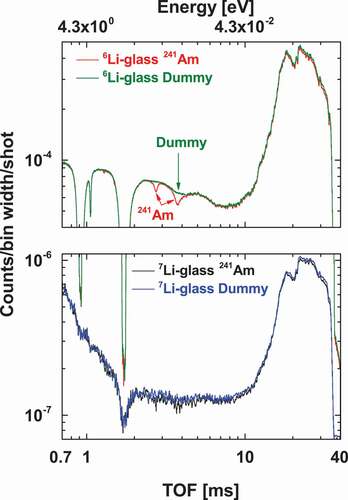
Dead-time corrections were made for the gated neutron TOF using a fixed dead time of 1264 ns due to the settings of the CAEN V1720. The dead-time corrections were 1.2% and 8.0% at the first resonance of 241Am (0.31 eV) and the thermal neutron energy, respectively. The dead time for the 7Li-glass detector was negligibly small in this experiment.
The net neutron TOF spectra of the 241Am and the dummy samples were determined by subtracting the backgrounds caused by gamma-rays and frame-overlap neutrons. The gamma-ray backgrounds were deduced from the gated neutron TOF spectra with the 7Li-glass detector. For the estimation of the frame-overlap neutron background, the gated neutron TOF spectra from 37 to 40 ms were fitted by an exponential decay function, and the fitted function was shifted to the left side by 40 ms. indicates the determined frame-overlap background of the 241Am sample. The deduced back ground shows good agreement with the black resonance of 115In (1.46 eV).
Figure 4. The gated neutron TOF spectra and the frame-overlap background of the 241Am sample. The red line shows the gated neutron TOF spectra measured by the 6Li-glass detector. The black line shows the deduced frame-overlap background.
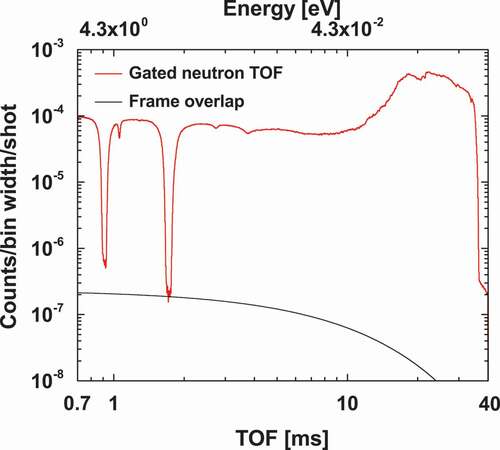
Finally, neutron total cross sections of 241Am, , were determined as follows:
where is the areal density of the 241Am sample (atoms/b),
is the neutron transmission ratio of the 241Am sample, C is the gated neutron TOF spectrum normalized with incident neutron intensity for each sample,
is the background due to gamma-rays, and
is the background caused by the frame-overlap neutrons. Neutron beam intensity determined by the number of the incident protons was used in order to normalize the neutron transmission ratio of 241Am. shows the obtained neutron transmission ratio of 241Am. The thickness of the 241Am sample was determined to be
atoms/b. This uncertainty was mainly caused by the uncertainty of 241Am sample diameter (
mm). Correction for incident neutron intensity was 0.47% by considering the number of the incident protons. The main component of the uncertainty for the neutron total cross section comes from the uncertainty of the sample diameter.
2.3. Results and discussion
The derived total cross section of 241Am is shown in . Cross sections taken from the previous measurements of Adamchuk et al. [Citation13], evaluated cross sections of JENDL-4.0 [Citation4] and JEFF-3.2 [Citation43] are also illustrated. The obtained total cross section at thermal energy was derived as b. Adamchuk et al. [Citation13] measured the total cross sections of 241Am in the neutron energy region from 6.3 meV to 82 eV using a reactor at Dubna. They prepared two 241Am samples with thicknesses of 0.521 and 0.0665 g/cm. Two types of BF3 detectors were used for neutron transmission measurements. Their results are systematically smaller than the present results by 15%. It might be caused by the incorrect sample thicknesses or a normalization of incident neutrons. In comparison with the present results, the evaluated thermal total cross section of JENDL-4.0 is 4.2% smaller, and that of JEFF-3.2 is 4.7% larger. ENDF/B-VII.1 [Citation44] has adopted the same value as JENDL-4.0.
Figure 6. The derived neutron total cross sections of 241Am (red points) with comparison to the results by Adamchk [Citation13] (black points), the evaluated values in JENDL-4.0 [Citation4] (blue line), and JEFF-3.2 [Citation43] (black line).
![Figure 6. The derived neutron total cross sections of 241Am (red points) with comparison to the results by Adamchk [Citation13] (black points), the evaluated values in JENDL-4.0 [Citation4] (blue line), and JEFF-3.2 [Citation43] (black line).](/cms/asset/af067f45-9ac3-4ba1-9d80-cf3e46260239/tnst_a_1485519_f0006_oc.jpg)
3. Neutron capture cross-section measurements
3.1. Experimental procedure
Measurements of neutron capture cross sections of 241Am have been performed at the ANNRI of the MLF. The 241Am sample was placed at the beam center position of the array of Ge detectors having a flight length of 21.5 m from the moderator and gamma-rays emitted from the sample were measured. The array of Ge detectors is composed of two cluster-Ge detectors, eight coaxial-Ge detectors and anticoincidence shields around each Ge detector [Citation45]. In the measurements, two cluster Ge detectors were used, but the coaxial Ge detectors were not used because they suffered from severe electrical noise. Additionally, a lead plate with a thickness of 5 mm was placed in front of each cluster Ge detector for attenuation of the intense decay gamma-rays from 241Am. The signals from the cluster-Ge detectors were digitized and analyzed with CAEN V1724 (14 bit, 100 MHz) ADC boards [Citation7]. The TOF and PH data were recorded in list-mode. The peak efficiency was at 1332 keV gamma-rays of 60Co [Citation46].
The accelerator was operated in a single-bunch mode at a repetition rate of 25 Hz. The proton beam power was 205 kW. The neutron beam was collimated to a diameter of 22 mm at the sample position. Neutrons traveled through a neutron beam duct, which housed the sample. Helium gas was flown into the beam duct to reduce scattering neutron background by air.
The same 241Am and the dummy samples were used as described in Section 2.1. A 197Au sample with a diameter of 10.0 ± 0.1 mm and a weight of 174 ± 1 mg was used as a standard for PH-weighting technique (PHWT) [Citation47]. An enriched 10B sample with a diameter of 10.0 ± 0.2 mm was utilized to determine the shape of the incident neutron energy spectrum. To estimate background due to scattered neutrons by the 241Am sample, an enriched 208Pb sample with a diameter of 5.0 ± 0.1 mm and a weight of 170 ± 1 mg was also used. All samples were packaged in bags made of fluorinated ethylene–propylene copolymer (FEP) films. Measurement of the FEP bag without any sample (blank) was carried out for background estimation in the case of the ‘no sample condition’. The measuring times were summarized in .
Table 2. Measuring times
3.2. Data analysis
3.2.1. Incident neutron energy spectrum
The incident neutron energy spectrum was determined by measuring 478 keV gamma-rays from 10B(n, )7Li reactions. TOF spectra gated in the 478 keV peak region were made for the 10B, 208Pb, and blank measurements. Sample-independent and sample-scattered neutron backgrounds were estimated using the TOF spectra of blank and 208Pb measurements and subtracted from the 10B TOF spectrum. The cross-section data of the 10B(n,
)7Li reaction in JENDL-4.0 [Citation48] were used to convert the detected counts to the number of the incident neutrons. The dead-time correction was made for the each TOF spectrum. The correction of the neutron self-shielding and multiple scattering in the 10B sample was made by using the Monte Carlo simulation code PHITS [Citation49]. The cross-section data used for the calculation were taken from JENDL-4.0. shows the derived correction factor. In this calculation, the uncertainties of the corrections were deduced from the uncertainties of the 10B sample diameter and mass. The value was 2.3% for thermal energy neutrons. The obtained incident neutron energy spectrum is shown in . The broad peak around 10 meV corresponds to the neutron bump thermalized in the liquid hydrogen moderator. The spectrum shows the typical
energy dependence from 0.1 to 100 eV.
3.2.2. PH weighting technique
A PHWT [Citation47] was applied to derive neutron capture yields of the 241Am and 197Au samples. PHWT is based on the physical fact that the total energy sum of the emitted gamma-rays following each capture reaction is equal to , where
is the neutron binding energy of the target nucleus and
is the center-of-mass energy of the incident neutron. In PHWT, the neutron capture yield Y is calculated as follows:
where is the weighting function of each cluster Ge detector, I is the channel number,
is a PH spectrum. The weighting function
was built from detector response functions. In this paper, weighting function
was normalized using the neutron capture cross section of 197Au in JENDL-4.0 [Citation50] at thermal energy. The neutron capture cross sections of 241Am,
, depending on incident neutron energy were obtained from the following equation:
where is the number of incident protons for each sample,
is the number of incident neutrons,
is neutron energy,
is thermal neutron energy, and
is the number of the 241Am atoms. The number of the 241Am atoms was derived by using the calorimeter, as described before.
For the present experimental setup, the response functions of the cluster-Ge detectors were calculated by Monte Carlo simulation using the Geant4 code [Citation51]. A comparison between calculated and measured response functions for a 60Co source is shown in . The peak areas on the 1173 and 1332 keV obtained by the Geant4 simulations were larger than the measured values by 0.6% and 1.9%, respectively. The cause of difference is that the measured 1173 and 1332 keV peaks have a contribution of low-energy tails.
Below 200 keV, the measured spectrum is smaller than the simulated result due to the threshold on the signal processing. Below a gamma-ray energy of 1000 keV, we calculated the response functions every 100 keV. In the gamma-ray energy region from 1000 to 10,000 keV, the response functions were calculated every 1000 keV.
Figure 9. A comparison between calculated and measured response functions for a 60Co source. The calculated response function was normalized with the number of emitted gamma-rays. Differences of the peak areas on the 1173 and 1332 keV between the experiment and the calculation were less than 2%.
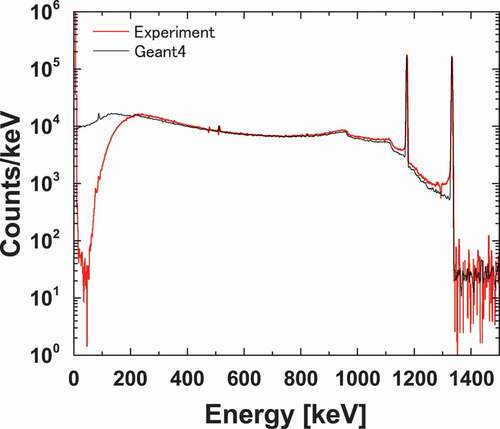
The weighting function was calculated from the corresponding response functions by assuming a trial function. Finally, the weighting function was normalized using the measurements of the Au sample and evaluated capture cross section of 197Au in JENDL-4.0 in the neutron range from 24.3 to 26.3 meV. indicates the calculated weighting function for the 241Am sample as an example. The deduced weighting function is described as follows:
The uncertainty of the weighting function was evaluated using the following equation:
where is the calculated response functions,
is gamma-ray energy, k is the normalization factor of the weighting function. L is the number of response functions and N is the number of degrees of freedom for the weighting function. The uncertainties of weighting functions caused by the response functions were estimated as 1%.
shows PH spectra for the 241Am, dummy, blank, and 208Pb measurements. These PH spectra except for the blank measurement were obtained by subtracting sample-independent background estimated from the PH spectra for the blank measurement. The PH spectrum for the 241Am decay measurement is also shown in the figure. The number of proton beam pulses was used for normalization in background subtraction. A difference appeared clearly between the 241Am and dummy PH spectra below the Q-value of 241Am(n, ) reaction (5538 keV). Additionally, backgrounds due to neutron capture reactions by the materials other than AmO2 (aluminum case and Y2O3) were also observed. For example, a 7724 keV prompt gamma-ray peak due to the 27Al(n,
)28Al reaction and a 6080 keV prompt gamma-ray peak caused by the 89Y(n,
)90Y reaction were clearly observed. The background due to scattered neutrons from each sample was mainly attributed to the 2223 keV capture gamma-rays from the 1H(n,
)2H reaction in the neutron shields of 6LiH and/or borated polyethylene blocks. The main part of decay gamma-ray background from the 241Am sample was observed below 1 MeV.
Figure 11. The PH spectra of the 241Am (red), dummy (black), 208Pb (blue), and 241Am decay (green) measurements. These PH spectra were normalized using the number of proton beam pulses. Sample-independent background estimated from the PH spectra for the blank measurement was subtracted.

Correction of undetected events below the threshold level of signal processing ( keV) was done by extrapolating the PH spectrum to lower energies. The PH spectrum was fitted by an exponential function from 200 to 600 keV, and the extrapolation of the PH spectrum below the threshold level (
keV) was made. In comparison to flat extrapolation of the PH spectrum, the uncertainties due to the extrapolation were estimated. Consequently, the uncertainties were 2.7% and 1.6% for the PH spectra on 241Am and 197Au, respectively.
Two-dimensional data of TOF and PH spectra were reduced into one-dimensional TOF data of the weighted sum that is proportional to the capture yield. represents the weighted sum TOF spectra of the 241Am, dummy, blank, and 208Pb. These weighted sum TOF spectra were normalized with the number of incident proton beam pulses. A peak located at 2.8 ms is due to the first resonance of 241Am (0.31 eV). Neutron resonances of the 241Am were clearly observed in the figure down to 0.1 ms, which is equivalent to a neutron energy of 260 eV. The broad peak around 20 ms is due to the neutron bump thermalized in the liquid hydrogen in the moderator. Furthermore, a neutron resonance peak of the 89Y (2.6 keV) appeared at 0.035 ms. To evaluate the amount of Y2O3 in the 241Am and the dummy samples, peak areas of this resonance were used.
3.2.3. Dead-time correction
Dead-time corrections were made for these weighted TOF spectra with extended dead-time model using a dead time of 5.67 ± 0.04 µs per event. illustrates the dead-time corrections of the weighted TOF spectra of the 241Am and the dummy samples. The dead-time corrections at neutron resonance peaks of the 241Am were 4.5% at the first resonance (2.8 ms) and 11% at the third resonance (1.4 ms). At the thermal energy, the dead-time correction factor was 1.01. The uncertainties of the correction were deduced using the uncertainty of the dead time per event. The deduced uncertainties were less than 0.1% at the thermal energy.
3.2.4. Background subtraction
The following backgrounds were subtracted from the weighted TOF spectrum of the 241Am sample: (1) the background due to aluminum container and Y2O3 included in the 241Am sample; (2) the background due to scattered neutrons from the 241Am sample; (3) the background caused by frame overlap neutrons, (4) the constant background due to decay gamma-rays. The background component of aluminum container and Y2O3 was estimated from the weighted TOF spectrum of the dummy sample considering difference of the amount of Y2O3 between the 241Am and the dummy samples. The peak areas of the 2.6 keV resonance of 88Y in the weighted TOF spectra were taken into consideration for the amount estimation. In order to estimate the background due to scattered neutrons from the 241Am sample, 208Pb measurement was used. Sample-independent background, which is represented by the weighted TOF spectrum of blank, was subtracted from the weighted TOF spectrum of 208Pb, and the background due to the scattered neutrons by the 208Pb sample was determined. Then, the background due to scattered neutrons by the 241Am sample was estimated on the assumption that the background is changed in proportion to the product of the neutron scattering cross section and the amount of target nuclei. The backgrounds caused by frame-overlap neutrons and decay gamma-rays were estimated by fitting the weighted TOF spectra in the TOF region from 37 to 40 ms by using the following function:
where ,
,
are fitting parameters. The fitted function was moved back in time by 40 ms. indicates the fitting region and the determined background due to frame-overlap neutrons and decay gamma-rays. The background component of decay gamma-rays is time independent. Therefore, the determined
includes the background due to decay gamma-rays. In the frame-overlap background subtraction, the contribution from the isotopic impurity of 239Pu in the 241Am sample was estimated to be less than 0.1% by considering the isotopic ratio and the capture and fission cross sections of 239Pu. In the similar way, background subtraction from the weighted TOF spectrum of the 197Au was made.
3.2.5. Correction for the neutron self-shielding and multiple-scattering effects
The corrections for the neutron self-shielding and multiple-scattering effects in the 241Am and 197Au samples were made by using the PHITS code [Citation49]. The dimension and weight of the samples were taken into account in the calculation. The correction for neutron self-shielding and multiple-scattering was made in the same way as boron data analysis described above. and show the determined correction factors of the 241Am and 197Au samples, respectively. As shown in and , the correction factors at the thermal energy were 0.3% and 2.4% for the 241Am and the 197Au samples, respectively. In this paper, enough large uncertainties of the corrections (10%) were assumed as a rough estimation. The deduced uncertainties were 0.03% for the 241Am sample and 0.24% for the 197Au sample. These values are enough small comparison to other uncertainties.
3.2.6. Correction for the fission reaction of 241Am
The correction for the fission reaction of 241Am was made assuming that the multiplicity (gamma-rays/fission) of fission reaction gamma-rays is 7.0 according to the study of Verbeke et al. [Citation52]. Then, the correction factor for the fission reaction was derived as follows:
where and
are capture and fission cross sections of 241Am,
, and
are the gamma-ray multiplicities of the capture and fission reactions. The cross-section data used for the correction were taken from JENDL-4.0 [Citation2]. Jandel et al. adopted the gamma-ray multiplicity of 4 for the 241Am(n,
) reaction [Citation31]. Typically, neutron capture gamma-ray multiplicities vary between 1 and 6 with an average value about 3.5. In this study, the capture gamma-ray multiplicity was assumed to be 3.5. The derived correction factors were shown in . Contribution of the corrections to the capture cross section was less than 1% at thermal neutron energy. In this paper, enough large uncertainties of the corrections (10%) were assumed as a rough estimation. The estimated uncertainty was less than 0.1% and enough small comparison to other uncertainties.
3.3. Results and discussion
The neutron capture cross sections of 241Am were obtained by dividing the background-subtracted 241Am TOF spectrum by the incident neutron spectrum. The thermal neutron capture cross section of 241Am was derived as b. The following uncertainties were taken into account for the capture cross section: (1) the statistical uncertainties of measured TOF spectra; (2) the uncertainty due to the standard capture cross section of 197Au at the thermal energy (
) [Citation53]; (3) the uncertainty of the sample mass for the 241Am sample; (4) the uncertainty caused by the weighting functions; (5) the uncertainties caused by the corrections for the dead time; (6) the uncertainties from the corrections for the neutron self-shielding and multiple-scattering effects for each sample; (7) the uncertainties due to the extrapolations of the capture gamma-ray PH spectrum for PHWT; (8) the uncertainty due to the correction for the fission reaction. The details of these uncertainties at the thermal energy were summarized in .
Table 3. Details of uncertainties for the derived thermal capture cross section of 241Am
shows the present results. The evaluated cross sections of JENDL-4.0 [Citation4] and JEFF-3.2 [Citation43] are also shown. The uncertainties of the determined cross sections were illustrated in . In the thermal energy region, JENDL-4.0( b) is smaller than the present results by 3.3% but agrees within the uncertainties, and JEFF-3.2 (748b) is larger by 5.5%. compares the present results with the previous measurements on the thermal neutron capture cross sections (
) of 241Am, where the thermal neutron capture cross sections to the ground state of 242Am (
) measured by the activation methods were evaluated using the branching ratio of
determined by Fioni et al. [Citation27]. By comparing the measured data in the last decade, the previous data except for the result of Belgya et al. [Citation32] were in good agreement with the present result within their uncertainties.
Table 4. The thermal neutron capture cross sections () of 241Am
Figure 18. The determined neutron capture cross sections of 241Am. (a) 0.01 - 2eV, (b) 2 - 10 eV and (c) 10 - 100eV.
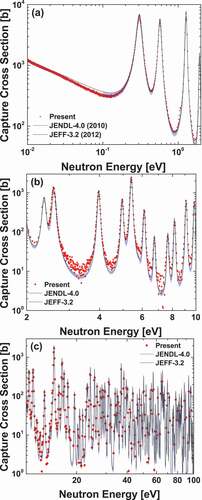
Figure 19. The uncertainties of the derived neutron capture cross sections of 241Am. A step appeared at neutron energy of 2.4 eV following a change of the TOF bin width.
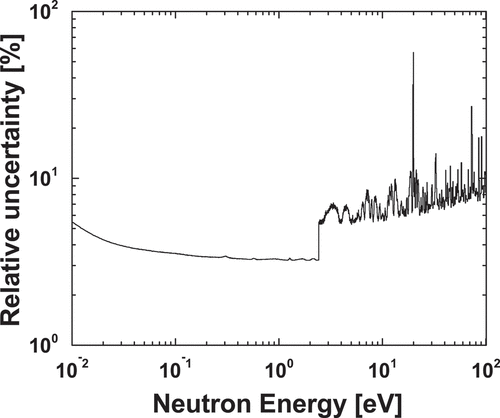
Fraval et al. [Citation35] measured the capture cross sections of 241Am in the neutron energy region from the thermal energy to 320 eV using the neutron TOF facility at the European Organization for Nuclear Research. They used a pair of C6D6 liquid scintillation detectors for capture gamma-ray detection. The amount of 241Am sample used for the experiments was quantified with an uncertainty of 2.2% by the calorimetric method. The thermal neutron capture cross section () of 241Am was reported to be
b. The uncertainty at the thermal energy mainly came from signal-to-background ratio. The result of Fraval et al. is 4.1% smaller than the present results.
Lampoudis et al. [Citation19] performed neutron transmission and capture cross-section measurements of 241Am in the neutron energy region from the thermal neutron to 110 eV using the Geel Electron Linear Accelerator (GELINA). They measured the amount of an 241Am sample with the uncertainty of 0.37% by calorimetric measurements. X-ray radiography was applied to determine the diameter of the 241Am sample (22.345 ± 0.030 mm), resulting in good accuracy. The transmission measurements were performed at a flight path of 25 m with a Li-glass scintillation detector (NE905) having a thickness of 12.7 mm. The capture measurements were carried at a 12.5 m measurement station with a pair of C6D6 liquid scintillation detectors, and the PHWT was applied. Measured capture cross sections of 241Am were normalized based on the combined analysis of transmission and capture data for the 0.31, 0.57, and 1.27 eV resonances of 241Am. The thermal neutron capture cross section () of 241Am was determined to be
b. Their result is 5.9% larger than the present results but agrees within the uncertainties.
Genreith et al. [Citation33] measured the thermal neutron capture cross sections to the ground state of 242Am by the activation method at the FRM II reactor. Two 241 Am samples with activities of and
MBq were irradiated by cold neutrons. Decay gamma-rays from the irradiated 241Am samples were measured with an n-type HPGe detector having a 60% relative efficiency. The thermal neutron capture cross section of each sample (
) to the ground state of each sample was derived to be
and
b, respectively. Then they reported the thermal neutron capture cross sections (
) of 241Am to be
and
b using the branching ratio measured by Fioni et al. [Citation27]. The results of Genreith et al. are in good agreement with the present results.
Jandel et al. [Citation31] measured the neutron capture cross sections of Am in the neutron energy region from 0.0253 eV to 320 keV with the detector for advanced neutron capture experiments (DANCE) at the Los Alamos Neutron Science Center. An 241Am sample with a weight of
µg determined by counting alpha-particles was used for the measurements. Capture gamma-rays emitted from the 241Am sample were measured with 4π BaF2 arrays located on the 20.2-m neutron flight path. They reported the thermal neutron capture cross section (
) of 241Am to be
b, which is 5.9% smaller than the present results but agrees within the uncertainties.
Belgya et al. [Citation32] measured the capture cross section () of 241Am by measuring X-rays from the decay product of 242Pu at the Budapest Research Reactor. It is noted that uncertainties ascribed to X-ray emission probabilities of 103.4 and 99.5 keV from 242Pu were the most dominant uncertainty component. The discrepancy of the thermal capture cross sections of 241Am might be caused by these X-ray emission probabilities. Additionally, Mizuyama et al. [Citation54] reported that the discrepancy can be improved by their new developed correction method considering an influence by the resonances near and below a Cd cutoff energy (0.5 eV).
4. Conclusions
The neutron total cross sections and neutron capture cross sections of 241Am were measured by the TOF method with the Li-glass detectors and the cluster-Ge detectors of ANNRI in J-PARC. The neutron total cross section was deduced in the neutron energy region from 4 meV to 2 eV and the obtained thermal total cross section was b. Compared with the value obtained in this work, the JENDL-4.0 is 4.2% smaller, and the JEFF-3.2 is 4.7% larger. The neutron capture cross sections of 241Am were deduced in neutron energies range from 10 meV to 100 eV. The thermal neutron capture cross section was derived as
b by using the PHWT using the thermal neutron capture cross section of 197Au in JENDL-4.0. The obtained neutron total and capture cross sections were consistent. We have developed the accurate experimental methods for capture cross-section and total cross-section determination for radioactive nuclei. Effectiveness of consistency check method was also successfully demonstrated. To achieve the goal improving k
estimation about a factor 3, the developed method is expected to be applied for other important cross-section measurements. On the capture cross section of 241Am, the uncertainty is improved from about 7% to about 4%. The result is expected to highly contribute achieving the required accuracy about 2–3% (one-third of about 7%) by combining future data to be measured at the facilities such as n_TOF in CERN, GELINA in JRC, and DANCE in LANL.
Acknowledgments
The author would like to thank the accelerator and technical staffs at J-PARC for operation of the accelerator and the neutron production target and for the other experimental supports. The neutron experiments at the Materials and Life Science Experimental Facility of the J-PARC were performed under the user programs (Proposal No. 2016P1001, 2015P1001, and 2014B0328).
Present study includes the result of ‘Research and Development for accuracy improvement of neutron nuclear data on minor actinides’ entrusted to the Japan Atomic Energy Agency by the Ministry of Education, Culture, Sports, Science and Technology of Japan (MEXT).
Disclosure statement
No potential conflict of interest was reported by the authors.
References
- Iwamoto H, Nishihara K, Sugawara T, et al. Sensitivity and uncertainty analysis for an accelerator-driven system with JENDL-4.0. J Nucl Sci Technol. 2013;50:856–862.
- Shibata K, Iwamoto O, Nakagawa T, et al. JENDL-4.0: a new library for nuclear science and technology. J Nucl Sci Technol. 2011;48:1–30.
- Salvatore M, Jacqmin R Uncertainty and target accuracy assessment for innovative systems using recent covariance data evaluations. WPEC-26, OECD NEA (2008).
- JENDL-4.0 data file for 241Am (MAT=9543), evaluated by Iwamoto N (2010).
- Harada H, Iwamoto O, Iwamoto N, et al. Accuracy improvement of neutron nuclear data on minor actinides. In Proceedings of the 15ʹth International Symposium on Capture Gamma-Ray Spectroscopy and Related Topics (CGS 15); 2014 August 25–29; Dresden, Germany. EPJ Web of Conferences 93.
- Harada H, Iwamoto O, Iwamoto N, et al. Research and development for accuracy improvement of neutron nuclear data on minor actinides. In Proceedings of the International Conference on Nuclear Data for Science and Technology (ND2016); 2016 September 11–16; Bruges, Belgium. EPJ Web of Conferences 2017;146:11001.
- Nakao T, Terada K, Kimura A, et al. Developments of a new data acquisition system at ANNRI. In Proceedings of the International Conference on Nuclear Data for Science and Technology (ND2016); 2016 September 11–16; Bruges, Belgium. EPJ Web of Conferences 2017;146:03021.
- Terada K, Nakao T, Kimura A, et al. Technical developments for accurate determination of amount of samples used for TOF measurements. In Proceedings of the International Conference on Nuclear Data for Science and Technology (ND2016); 2016 September 11–16; Bruges, Belgium. EPJ Web of Conferences 2017;146:03019.
- Hirose K, Furutaka K, Hara K, et al. Cross-section measurement of 237Np(n,γ) from 10 meV to 1 keV at Japan proton accelerator research complex. J Nucl Sci Technol. 2013;50:188–200.
- Harada H, Ohta M, Kimura A, et al. Measurements of 241Am(n, γ) at J-PARC/MLF/ANNRI. Nuclear Data Sheets. 2014;119:61–64.
- Kimura A, Fujii T, Fukutani S, et al. Neutron-capture cross-sections of 244Cm and 246Cm measured with an array of large germanium detectors in the ANNRI at J-PARC/MLF. J Nucl Sci Technol. 2011;49:708–724.
- Mendoza E, Cano-Ott D, Guerrero C, et al. Measurement and analysis of the 243Am neutron capture cross section at the n_TOF facility at CERN. Phys Rev C. 2014;90:034608.
- Adamchuk JV, Gerasimov VF, Efimov BV, et al. The fission and total cross-sections measurement for heavy elements isotopes by monochromatic neutrons using mechanical selector. In Proceedings of the International Conference on Peaceful Uses of Atomic Energy; 1955 August 8; Geneva, Schweizerische. Vol.4, p.259.
- Slaughter GG, Block RC, Harvey JA. High-resolution total cross section measurements on 237Np and 241Am using the ORNL fast chopper. Am Phys Soc. 1961;6:70.
- Derrien H, Lucas B The total cross section and the fission cross section of 241Am in the resonance region. In Proceedings of the International Conference on nuclear cross sections and technology; 1975 March 3–7; Washington, D.C., USA. Vol. 2, p. 637.
- Belanova TS, Kolesov AG, Nikolaev VM, et al. Parameters of the neutron resonances of 241Am in the energy range from 8 to 30 eV. Sov At Energy. 1975;38:29.
- Kalabin SM, Artamonov VS, Ivanov RN, et al. Total neutron cross section and neutron resonance parameters of 241Am in the energy range 0.004–30 eV. Sov At Energy. 1976;40:303.
- Phillips TW, Howe RE. Total neutron cross section for Americium-241. Nucl Sci Eng. 1979;69:375–377.
- Lampoudis C, Kopecky S, Bouland O, et al. Neutron transmission and capture cross section measurements for 241Am at the GELINA facility. Eur Phys J Plus. 2013;128:86.
- Shibata K, Kawano T, Nakagawa T, et al. Japanese evaluated nuclear data library version 3 revision-3: JENDL-3.3. J Nucl Sci Technol. 2002;39:1125–1136.
- Pomerance H. Absorption cross sections for long-lived fission-product Zr93, Am241, and enriched stable platinum isotopes, in Physics Division Semiannual Progress Report (ORNL). 1955; 5055.
- Bak MA, Krivokhatskii AS, Petrzhak KA, et al. Cross sections and resonance integrals for capture and fission in long-lived americium isotopes. Atomnaya Energiya. 1967;23:316.
- Dovbenko AG, Ivanov VI, Kolesov VE, et al. Am-241 radiative neutron capture. Centr Po Jadernym Dannym, Obninsk. 1969;6:42.
- Harbour RM, Mac Murdo KW, Crosson FJ. Thermal-neutron capture cross sections and capture resonance integrals of Americium-241. Nucl Sci Eng. 1973;50:364.
- Gavrilov VD, Goncharov VA, Ivaneko VV, et al. Thermal cross sections and resonance integrals of fission and capture of Am-241, Am-243, Bk-249, and Cf-249. Atomnaya Energiya. 1976;41:808.
- Shinohara N, Hatsukawa Y, Hata K, et al. Radiochemical determination of neutron capture cross section of 241Am. J Nucl Sci Technol. 1997;34:613–621.
- Fioni G, Cribier M, Marie F, et al. Incineration of 241Am induced by thermal neutrons. Nucl Phys. 2001;693:546–564.
- Maidana NL, Dias MS, Foskinas MF. Measurement of the thermal neutron capture cross section and resonance integral of Am-241. Radiochimica Acta. 2001;89:419–423.
- Bringer O, AlMahamid I, Chabod S, et al. Measurements of thermal fission and capture cross sections of minor actinides within the Mini-INCA project. In Proceedings of the International Conference onNuclear Data for Science and Technology 2007; 2007 April 22–28; Nice, France. p. 619–622.
- Nakamura S, Ohta S, Harada H, et al. Thermal-neutron capture cross section and resonance integral of Americium-241. J Nucl Sci Technol. 2007;44:1500–1508.
- Jandel M, Bredeweg TA, Bond EM, et al. Neutron capture cross section of 241Am. Phys Rev C. 2008;78:034609.
- Belgya T, Szentmiklosi L, Kis Z, et al. Measurement of 241Am ground state radiative neutron capture cross section with cold neutron beam. IAEA Report INDC (HUN). 2012;0037.
- Genreith C, Rossbach M, Révay Z, et al. Determination of (n,γ) cross sections of 241Am by cold neutron activation. Nuclear Data Sheets. 2014;119:69–71.
- Lampoudis C, Kopecky S, Bouland O, et al. Neutron transmission and capture cross section measurements for 241Am at the GELINA facility. Eur Phys J Plus. 2013;128:86.
- Fraval K, Gunsing F, Altstadt S, et al. Measurement and analysis of the 241Am(n,γ) cross section with liquid scintillator detectors using time-of-flight spectroscopy at the n_TOF facility at CERN. Phys Rev C. 2014;89:044609.
- Hirose K, Nishio K, Makii H, et al. Simultaneous measurement of neutron-induced fission and capture cross sections for 241Am at neutron energies below fission threshold. Nucl Instruments Methods Phys Res Section. 2017;856:133–138.
- Žerovnik G, Schillebeeckx P, Cano-Ott D, et al. Improving nuclear data accuracy of 241Am and 237Np capture cross sections. In Proceedings of the International Conference on Nuclear Data for Science and Technology (ND2016); 2016 September 11–16; Bruges, Belgium. EPJ Web of Conferences 2017; 146:11035.
- Maekawa F, Harada M, Oikawa K, et al. First neutron production utilizing J-PARC pulsed spallation neutron source JSNS and neutronic performance demonstrated. Nucl Instruments Methods Phys Res Section. 2010;2010(620):159165.
- Shibahara S, Hori J, Takamiya K, et al. High precision analysis of isotopic composition for samples used for nuclear cross-section measurements. In Proceedings of the International Conference on Nuclear Data for Science and Technology (ND2016); 2016 September 11–16; Bruges, Belgium. EPJ Web of Conferences 2017; 146:03028.
- Igashira M, Kiyanagi Y, Oshima M. Nuclear data study at J-PARC BL04. Nucl Instruments Methods Phys Res Section. 2009;600:332–334.
- Kino K, Furusaka M, Hiraga F, et al. Measurement of energy spectra and spatial distributions of neutron beams provided by the ANNRI beamline for capture cross-section measurements at the J-PARC/MLF. Nucl Instruments Methods Phys Res Section. 2011;626:58–66.
- Syme DM. The black and white filter method for background determination in neutron time-of-flight spectrometry. Nuclear Instruments Methods. 1982;198:364– 365.
- JEFF-3.2 data file for 241Am (MAT=9543), evaluated by CEA/NRG/IRMM collaboration (2014).
- ENDF/B-VII.1 data file for 241Am (MAT=9543), evaluated by Kawano T and Chadwick M B (2011).
- Kimura A, Fujii T, Fukutani S, et al. Neutron-capture cross-sections of 244Cm and 246Cm measured with an array of large germanium detectors in the ANNRI at J-PARC/MLF. J Nucl Sci Technol. 2012;49:708–724.
- Kin T, Furutaka K, Goko S, et al. Development of a 4-pi germanium spectrometer for nuclear data measurements at J-PARC. In Proceedings of the International Conference on 2009 IEEE Nuclear Science Symposium and Medical Imaging; 2009 October 25–31, Orland, USA. pp. 2531.
- Macklin RL, Gibbons JH. Capture-cross-section studies for 30–220 keV neutrons using a new technique. Phys Rev. 1967;159:1007–1015.
- JENDL-4.0 data file for 10B (MAT = 525), evaluated by Chiba S (2010).
- Sato T, Niita K, Matsuda N, et al. Particle and heavy ion transport code system PHITS version 2.52. J Nucl Sci Technol. 2013;50:913–923.
- JENDL-4.0 data file for 197Au (MAT=7925), evaluated by Iwamoto N (2010).
- Allison J, Amako K, Apostolakis J, et al. Recent developments in Geant4. Nucl Instruments Methods Phys Res Section. 2016;835:186–225.
- Verbeke JM, Hagmann C, Wright D. Simulation of neutron and gamma ray emission from fission and photofission. UCRL-AR-228518-REV-1, Lawrence Livermore National Laboratory; 2016.
- Carlson AD, Pronyaev VG, Smith DL, et al. International evaluation of neutron cross section standards. Nuclear Data Sheets. 2009;110:3125–3324.
- Mizuyama K, Iwamoto N, Iwamoto O. Correction of the thermal neutron capture cross section of 241Am obtained by the Westcott convention. J Nucl Sci Technol. 2017;54:74–80.

